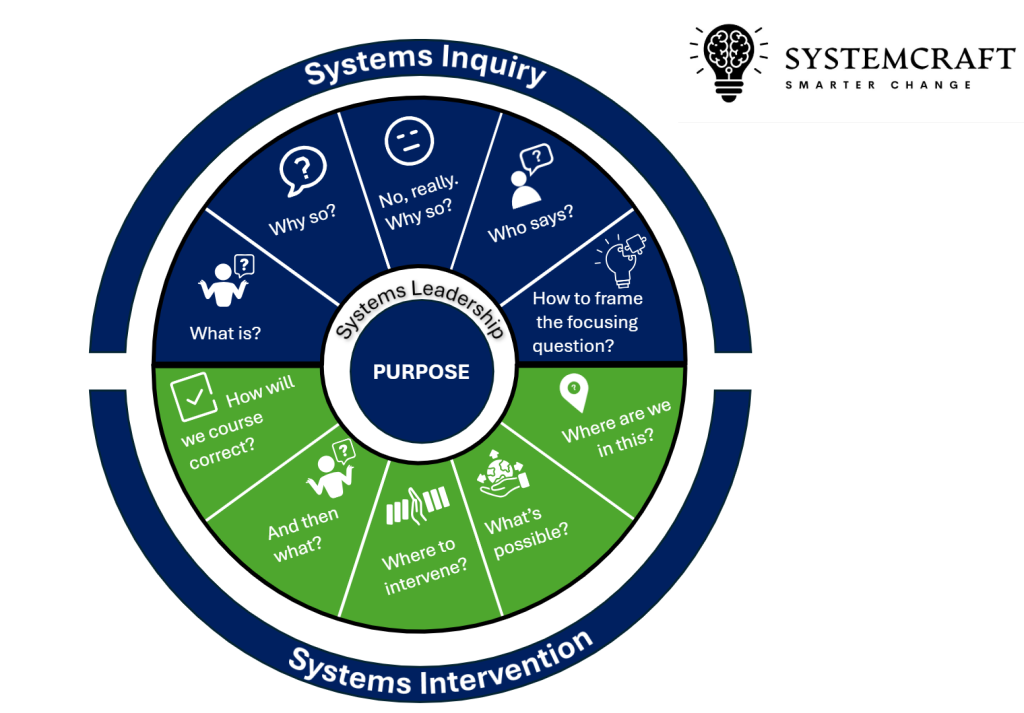13 Introduction to Systems Intervention

Figure 10. Systemcraft. Systems Intervention. (Joyner, 2025)
Introduction to Systems Intervention
While Systems Inquiry helps us understand complex systems, Systems Intervention is about engaging with them in thoughtful ways. Effective intervention requires more than just action; it demands strategic thinking, ongoing reflection, and adaptability. Without a structured approach, interventions risk reinforcing existing issues or creating unintended consequences.
It’s important to recognise that the idea of intervention is contentious in the systems thinking literature. Systems thinkers argue that every intervention changes the system in ways that may be unpredictable; again, this suggests that policy prototyping and adaptive governance are necessary while acknowledging that outcomes are never fully within our control. Also, systems thinkers (including Donella Meadows) reject the idea of the ‘silver bullet solution’, or in fact the concept of ‘solution.’ They are more likely to argue that complex problems require analysis of trade-offs; it’s often impossible to act without negative consequences somewhere else in the system.
With these caveats in mind, this module introduces the core elements of the Systems Intervention process: Where am I in this? What’s possible? Where to intervene? And then what? and How will we course correct? These five components provide a roadmap for navigating complexity and enacting change in a way that is both thoughtful and responsive.
Where am I in this? – Understanding the Role of the Intervener
The first step in any intervention is recognising our own position within the system. Every individual or organisation engaging in change is not external to the system but embedded within it. This means acknowledging biases, incentives, and the impact of personal or institutional perspectives. Reflexivity is key: understanding how one’s actions, assumptions, and relationships shape the system and how the system, in turn, influences those engaging with it. By asking Where am I in this?, leaders ensure they are not unconsciously reinforcing the very structures they aim to change.
What’s Possible? – Identifying Opportunities for Change
Before determining where to intervene, it is essential to explore what change is plausible and feasible within the system’s constraints and affordances. Not all interventions are equally viable; some may be aspirational but unachievable, while others may offer incremental yet meaningful progress. This phase involves using your Systems Inquiry insights to find ways forward.
Where to Intervene? – Finding Leverage Points for Impact
Once possibilities have been mapped, the next question is Where to intervene? This is identifying the points within the system where actions will have the greatest impact. Donella Meadows’ (1999) leverage points framework is a valuable tool at this stage, highlighting that not all intervention points are equally effective. Some interventions tweak parameters and provide minor adjustments, while others address deeper structural dynamics such as feedback loops, power structures, and paradigms. Successful systems leadership requires distinguishing between surface-level fixes and transformative opportunities for change.
And Then What? – Anticipating Consequences and Systemic Responses
Systems do not remain static in response to interventions; they push back, adapt, and sometimes evolve in unexpected ways. Asking And then what? ensures that leaders anticipate second-order consequences, emergent behaviours, and unintended ripple effects. The question also helps us think beyond an immediate crisis reaction to what will make for a sustainable system in the long term. A successful systems intervention is not a one-time action but an iterative process requiring ongoing evaluation and adjustment.
How Will We Course Correct? – Embedding Adaptive Learning
No intervention plan is foolproof, and complexity means that unanticipated challenges will inevitably arise. How will we course correct? highlights the importance of adaptive learning, ensuring that interventions are not rigid but responsive to changing circumstances. This requires establishing mechanisms for continuous feedback, learning from missteps, and refining strategies in real time. Systems leadership demands a mindset of experimentation, where failure is seen as a source of insight rather than a setback. Embedding structures such as rapid feedback loops, iterative piloting, and double-loop learning ensures that interventions remain effective over time. Systems leadership also ensures that information is allowed to flow through the system and feedback has its appropriate response to maintain system viability.
Conclusion
Systems Intervention is not about implementing static solutions but engaging dynamically with complexity to create meaningful and sustainable change. By rigorously applying the five components, Where am I in this?, What’s possible?, Where to intervene?, And then what?, and How will we course correct?, leaders and change agents can navigate uncertainty with greater confidence. The following chapters will explore each of these components, providing the tools and frameworks needed to lead systemic change effectively.
References
- Joyner, K. (2025) Systems thinking for leaders. A practical guide to engaging with complex problems. Queensland University of Technology. https://qut.pressbooks.pub/systemcraft-systems-thinking/
- Meadows, D. H. (1999). Leverage points: Places to intervene in a system. The Sustainability Institute.

